The next thing in crossovers is … smaller crossovers.
Honda led the way earlier this year when it introduced the HR-V, which is basically a smaller-scale take on the very successful (mid-sized) CR-V. It gives Honda buyers who want a CR-V, but less of it, a vehicle that fills the bill.
Mazda’s counterpoint is the CX-3.
Like the HR-V, it is also a subcompact crossover SUV and offers all-wheel-drive. But unlike the Honda, which emphasizes practicality (it has the most interior space – including twice the cargo space) the CX-3’s all about style and performance.
Handling, especially – at which it excels.
But, as a result, it’s … less practical than the HR-V.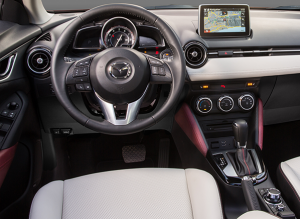
Which is a good thing, because it gives you a real choice for once.
These are two very different rides, even though they are rivals.
WHAT IT IS
An alternative to the HR-V.
Something that appeals more to the emotions than the roomier but stuffier (and much slower) Honda.
The CX-3 looks a lot like the Mazda3 hatchback but stands taller – and unlike the front-wheel-drive-only 3, you can order the CX-3 with AWD.
Unfortunately – and unlike the 3 – you cannot order the CX with a manual transmission. Strangely, the sportier-in-looks Mazda is automatic only while its less racy-looking (and much slower-moving) Honda rival can be ordered with a six-speed stick.
Base price for a FWD Sport 2.0 trim is $19,960; with AWD, the MSRP is $21,210.
A top-of-the-line Gran Touring with AWD lists for $26,240.
WHAT’S NEW
The CX-3 is the latest addition to Mazda’s lineup.
WHAT’S GOOD
It’s a looker.
It’s a handler.
Small footprint.
No manual transmission option(for us).
No upgrade engine option.
Small trunk.
Blizzard of “safety” systems e-noise (radar/laser signals) interferes with radar detectors and makes them next-to-useless.
UNDER THE HOOD
Regardless of trim and whether you go FWD or AWD, all CX-3 come with Mazda’s 2.0 liter “SkyActive” (basically, very high compression) four cylinder paired with a conventional (not CVT or automated manual) six-speed automatic.
The engine is similar to the 2.0 engine used in the CX-3’s car cousin – the Mazda3 – but the tuning is very different.
It makes a bit less horsepower and torque (146 hp and 146 ft.-lbs., respectively – vs. 155 hp and 150 ft.-lbs. for the Mazda3’s 2.0 engine) but the CX3’s max horsepower is developed 500 RPM sooner (at 6,000 RPM vs. 6,500 for the Mazda3’s 2.0 engine) and peak torque is developed much sooner (at 2,800 RPM vs. 4,300 RPM in the Mazda3).
Credit the 13.0:1 compression ratio, which helps the engine make big torque (for its size) and sooner (and without a turbocharger).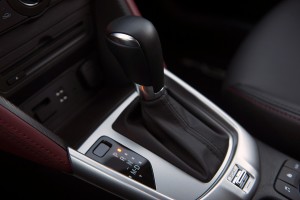
The torque, especially, makes the CX-3’s 2.0 engine tractable when paired with an automatic – which is a good thing because it’s the only thing you can pair it with. Probably because of government fuel efficiency requirements. The tests are easier to score higher on with an automatic, which will perform uniformly no matter who the driver is and which can be programmed to shift in such a way as to optimize the EPA numbers. The CX’s automatic also has not one but two overdrive gears. Fourth is 1:1 while fifth takes it up to .708 and in sixth, the ratio is down to .59. That’s deep overdrive gearing.
Proof of the automatic’s advantages is furnished by the automatic-equipped CX-3’s numbers – which are better than the numbers achieved by the manual-equipped Honda HR-V: 29 city, 35 highway (with FWD) vs. 25 city, 34 highway for the Honda (also FWD).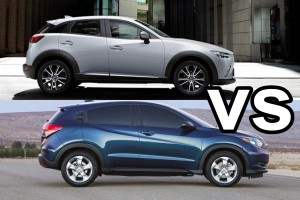
With its optional CVT automatic, the Honda almost (but not quite) matches the automatic CX-3’s numbers: 28 city, 35 highway.
But it can’t match the Mazda’s performance numbers.
The HR-V is slow.
The CX-3 isn’t.
It takes the Mazda about 8.4 seconds to get to 60 (FWD versions; the slightly heavier AWD version requires another tenth or so) vs. nearly 10 seconds for the Honda.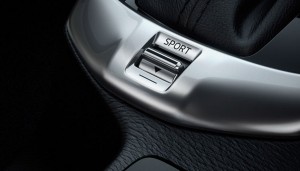
And it’s not just because the HR-V has less engine (1.8 liters, 141 hp). It also has more curb weight – 2,888 lbs. for the FWD version vs. 2,809 lbs. for the FWD version of the CX-3.
Another factor hobbling the Honda is the double punch of low torque (127 ft.-lbs) that doesn’t get made until 4,300 RPM. That combo is not the ticket with the optional CVT automatic.
Which is probably why Honda offers a manual.
It at least makes the HR-V feel a little quicker than it is. Even if it’s still much slower than the CX-3.
Reading the above, you may be surprised to hear me kvetch about the CX-3’s one-size-fits-all powertrain.
But given the hot-to-trot looks of the CX-3 (and expectations accompanying) it’s hard to grok why Mazda chose not to offer a manual transmission in this thing.
Or (as in the Mazda3 hatchback sedan) an optional engine.
The absence of the stick is almost certainly a function of CAFE (government fuel efficiency) ukase. Probably also it’s the reason for the absence of the Mazda3’s optional 2.5 liter, 184 hp engine as a CX-3 option.
But then, I went and read the specs. As it turns out, the Mazda3 with the 2.5 liter engine and six-speed manual manages a pretty spectacular 25 city, 37 highway. These are better numbers than the 2.0/automatic-equipped CX-3!
So (cue mournful C Low Green wail) … why?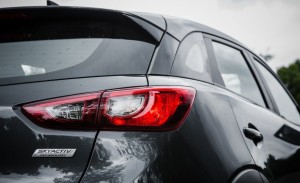
With the 184 hp engine the CX-3 (which actually weighs less than the Mazda3) would be a missile. At least, it would be about three seconds quicker to 60 than the HR-V and that would (and should) embarrass Honda. Even more important, it would likely draw aways sales given the much quicker (and much better-looking) Mazda would still give you as good or better fuel economy as the slow-motion HR-V.
Hopefully, someone at Mazda will read this.
The high-compression 2.0 liter SkyActive engine likes to rev, as high compression engines tend to. The decent torque spread provides good low-speed and mid-range thrust, too. The Honda has to work harder to achieve comparable speed. Both, however, begin to get winded once you’re up to speed. Floor the accelerator at 70 and not much acceleration occurs. It takes a while to achieve 100 and there’s not much beyond that.
Not that you’d ever do that, of course.
Where the CX-3 shines most (especially relative to the HR-V) is in the corners. Like all Mazda vehicles, it’s tuned to apex and is eager to do so. You can get 18-inch wheels/tires from the factory (the HR-V maxxes out with 17s) and the CX-3 also sits lower to the ground by about half an inch, which also helps.
Of course, neither the decreased ground clearance nor the increased width wheels/tires are helpful in the snow – which is where the HR-V outshines the CX.
You pays your money and you takes your choice.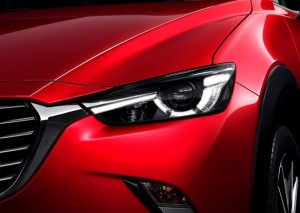
One area of aggravation with the CX is the e-clutter generated by the car’s array of “safety” systems. In particular the optional (thankfully) i-Activesense package that includes a forward collision-mitigation system that automatically applies the brakes when an object is sensed in the vehicle’s path and the driver doesn’t apply the brakes when the computer thinks he ought to.
Be aware that threes systems are typically (as here) over-cautious to an absurd (and distracting) degree. A deftly performed break left/accelerate/pass-a-slowpoke move, for example, can trigger a frantic light (and sound) show if the computer thinks you cut it too close. Which means, you didn’t leave a car length’s distance between you and the car you just passed.
The Safety Cult will be the death of driving fun.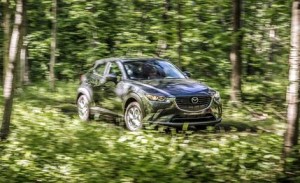
Also, the systems – which emit radar/laser even when you’ve depressed the “off” buttons – wreak havoc with radar detectors. The current state of detector filtering software is still not good enough to filter out – and disregard – the K band radar and laser signals (which cops also use) generated by the car. So you get multiple – and perpetual – false alarms.
This renders the detectors effectively useless, which renders you vulnerable to cop radar – and tickets. It kind of defeats the purpose of buying a car like this.
I’d much rather Mazda would offer a factory-installed radar detector (they’re legal everywhere except Virginia) than make radar detectors useless by fitting the car with all this “safety” crap.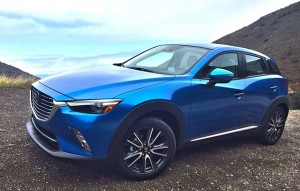
Good drivers don’t need it – and the bad ones don’t buy Mazdas.
AT THE CURB
If looks matter, it’s no contest.
The CX-3 is the Jennifer Lawrence of its class. Sleek, curvy in all the right places.
But, like pretty much anything that tugs at you emotionally, there are strings attached.
Like a lack of space inside that sexy shell.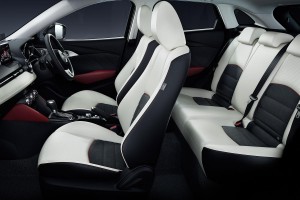
Though they are almost exactly the same overall length (168.3 inches for the Mazda and 169.1 for the Honda) the HR-V has an incredible 4.3 inches more backseat legroom (39.3 inches vs. 35 for the CX) and twice the cargo room behind the backseats (24.3 cubic feet vs. a Miata-esque 12.4 for the CX; 10.2 if you buy the Bose audio upgrade, which includes a trunk-mounted subwoofer that chews down the available space that much more).
Even with the second row folded, the CX can’t touch the HR-V when it comes to being capable of carting things around: 44.5 cubic feet vs. 58.8 in the Honda.
But utilitarian motives aren’t why you’re looking at this one, right?
What you like – in addition to the Jennifer Lawrence exterior – is the fighter-jock cockpit of the CX, right down to the fighter jet-esque Heads Up Display – not offered in the Honda – and the large (seven inch) free-floating LCD touchscreen (it’s standard in all trims, too). These features – plus brushed metal trim and aircraft-style ball air vents – add to the CX’s let’s-go-strafe-something vibe. It’d be cool if they included a target crosshair with the HUD.
The rotary knob selector mechanism for the LCD display is not as well-thought-out, however. It takes two steps to do various things that ought to just take one – like change the radio station, for example. First, you have to scroll to the << or >> icons and then you can push the knob to change the station.
If you’ve followed my rants, you’ll know that Mazda has decided against bringing its superb Sky-D diesel engine to the U.S. – because of the U.S. government’s regulatory burdens. Getting the diesel certified for sale here would either entail too much cost or too much of a reduction in the fuel efficiency of the powerplants – or some of both. Regardless, the government has made it very difficult for anyone to sell a diesel engine in a passenger car that’s not a high-end car (Benz, BMW, Audi) where the cost issues, at least, aren’t such a big factor.
But they are a huge factor for cars in the CX’s price range.
If the “cost of Uncle” is high enough such that it’ll take years to reach the point at which the diesel engine starts to save you money, most people will pass.
So, no diesel. And no manual transmission.
No optional engine, either.
Thank Uncle.
I mentioned the lesser practicality of the CX-3 vs. the HR-V. Here’s another thing to consider – if you don’t mind even less practicality: The Nissan Juke.
It has an almost unusable back seat (32 inches of legroom; three inches less than the CX) and a micro-trunk (10.5 cubes) but you can get it with a 215 hp turbocharged engine (NISMO RS trim) and even the as-it-comes Juke gives you 188 hp and a 7.3 second 0-60 run.
The Juke’s also available with AWD – though the same issues (not much ground clearance, tires meant for dry weather grip more so than fording through the snow) apply.
Still, it’s something to consider.
Another one to consider, if you don’t really care that much about AWD – but do care about a manual transmission – is the Mazda3. Which is so similar in profile and pretty much everything else (except the availability of AWD and the option of an underhood upgrade) that it, too, might be worth a look. The CX-3 stands taller than the Three – 60.7 inches off the ground vs. 57.3 for the Three – but both have exactly the same ground clearance (6.1 inches) so although you sit a little higher, it’s likely a FWD Three with winter tires would do just as well in the snow as a FWD CX-3 with the same tires…
But in the Three, you’d be able to shift for yourself (if you wanted).
Final thing: Despite its very high compression ratio, the CX’s engine is designed to run best on regular 87 octane unleaded – not premium. This is pat-on-the-back worthy. You get the power – without the expense of a turbo. Or the expense of having to buy premium fuel – as almost all turbo engines require.
THE BOTTOM LINE
It’s nice that Mazda didn’t just stamp out another version of everyone else’s small-scale crossover SUV. Like it or don’t like it, at least it’s different!
If you value independent media, please support independent media. We depend on you to keep the wheels turning!
Our donate button is here.
If you prefer to avoid PayPal, our mailing address is:
EPautos
721 Hummingbird Lane SE
Copper Hill, VA 24079
PS: EPautos stickers are free to those who sign up for a $5 or more monthly recurring donation to support EPautos, or for a one-time donation of $10 or more. (Please be sure to tell us you want a sticker – and also, provide an address, so we know where to mail the thing!)


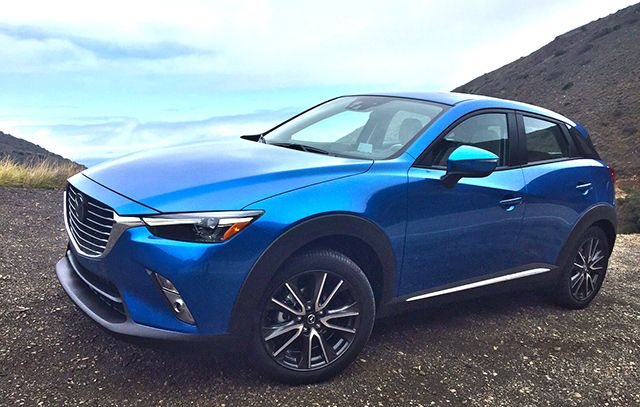











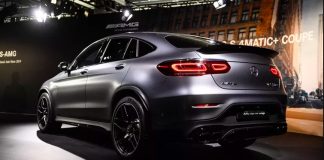
We picked up one of these beautiful rides a couple of months ago for my wife. After driving it once, I knew it was just sporty enough for me to not hate it, and not so sporty that my wife would hate it. It turns out she actually loves the feel of driving it.
**Worth noting that Mazda will bend over backwards to get one of these into your hands and onto the road, since it’s a new model and they’re a relatively small car manufacturer.
Smaller crossover == station wagon?
Bring back the Vista Cruiser!
Hi Eric,
Hell yeah!
If only…
Imagine: Nine passenger seating (two rear facing jumpseats)…. 455 V8 under the hood… and not a got-damned air bag in sight!
My neighbor has one. Bright yellow, hood scoop and Crager chrome wheels. Makes a great noise, would love to see it smoke the tires sometime.
I just took the old battlewagon out… really does make me feel like I am piloting the Scharnhorst against impossible odds… when the shaker scoop flapper door opens and the Quadrajet moans, it’s like I’m firing the turrets in a desperate salvo against the eternal, implacable foe…
LOL! You win the “obscure reference of the day award!”
https://en.wikipedia.org/wiki/German_battleship_Scharnhorst
Hey! Us older folks know about the Scharnhorst! It is the young pups that so fail to study history so they can repeat it!
David Ward
Memphis, Tennessee
Just an addition, most people do remember the Bismark. But only because the British bragged about sinking the thing when it was completely helpless. Only psychopaths would do something like that. Given the ship was totally incapacitated it would have been humane to first ask if the ship’s captain wished to surrender. If not, all they had to do was wait until the damn thing ran out of fuel. No way the ship could make it to port with a rudder that can’t be repaired at sea. 2K plus possible POWs what a waste of human life. How I despise governments.
David Ward
David, that’s the point many have made, ok, a few have made. Most wanted to make it sound as if the Bismark was a flying devil incapable of being sunk but the plucky Brit’s were supermen. They also had the option after sinking it to pick up survivors but they didn’t, a black mark on any force.
But you’re right about sinking it, they didn’t have to and could have captured it or at the least, given the captain the option of saving his men. No matter how it goes to the bottom, not giving the crew a chance is reprehensible to say the least.
eric, that would have done more for me today than some young strange. I drove lots of T/A’s and had the same thrill each time. They were/are smooth rides. As a passenger I always loved to watch that scoop twist around in the opening. WAAAAAAAAA
eric, I recall back in the day one of the guys at Car and Driver had taken a new foreign sports car, seems like a Fiat of some sort. He said he stopped at a light and the other lane was occupied by a Vista Cruiser with mom and the kids just picked up from school. She was talking to the kids and unaware of him(hurt his ego) in his hot new sex car. So he decides he’d blow her into the weeds for ignoring him. She never did acknowledge him and while he was stirring gears at WOT she was still talking to the kids as she simply left him struggling well behind her and disappeared from his view. So much for “hot” sports cars he says. It was a very funny article.
It’s a cute little thing.
But 8.4 seconds to 60 is just boring. And sporty handling is no substitute.
Mini SUVs simply are not about “fun.” So in this class, I’d look for at least a bit of off road ability, and maximum cargo capacity.
I got off the Mazda bandwagon when they stopped building the RX-7. Know the brand doesn’t miss me a bit. Slow, cute, and economical, with “sporty” handling obviously works for a lot of buyers. But I still miss those long, long gone days…. when Mazdas were actually known as “fast.”
Hi Mike,
I’m hoping they decide to make a Speed version of this one. They should.
But the real problem is the got-damned government. CAFE pressure is systematically “de-engining” the fleet – not just Mazdas. And it was the government that killed the RX-7, via the EPA.
Why does the manual Honda XRV use more fuel than the automatic?
It’s simple, gearing favors the automatic for economy.
The final ratio in the CVT is 5.4:1 and top gear is 0.4:1, which makes the ratio 2.2:1. The corresponding ratios for the manual are 4.7:1 with a 0.7:1 overdrive resulting in 3.3:1. That’s the reason the manual uses more fuel, the engine is always spinning faster.
CC, (although the question is open to all)
Is there a reason why car manufacturers don’t give manual transmissions an equivalent final ratio to an automatic transmission?
I think it has to do with leverage.
A manual car doesn’t have the torque multiplication assist provided by a torque converter, so instead a more aggressive ring and pinion is used to help launch the car.
Launch is not the function of the differential. Torque multiplication, that’s why transmissions have multiple gears rather than just a final drive like a steam or electric powerplant. ICE demands an aggressive first gear compared to the top gear, gearing the differential depend entirely upon the engine and purpose of the machine. Installing the proper ratios within the transmission will provide sufficient torque multiplication in conjunction with the final drive gearing while keeping the engine operating within a reasonable power band. Differential gearing supplements the transmission, not the other way around.
My guess, six speeds in a manual gear box are too many for the typical consumer to choose from. Hunting and pecking between first and sixth required a drive line that gives the engine plenty of forgiveness. The umpteen speed automatics with silicon brains do the same thing, just much quicker but kind of jerky and rough compared to the simpler trannies of yesteryear.
VW keeps similar gearing among their automated and manual transmissions. I think that’s because Honda buyers focus on being transported by the vehicle while VW buyers are attuned to driving the vehicle. Culture clash, driving is a chore versus driving is a pleasure.
Hi CC,
I think the automated manuals lack the conventional automatic’s torque converter… I need to “hip” myself to the mechanical functionings of these boxes… the dual-clutch/automated manuals. I understand conventional (hydraulic) automatics… and prefer them because they’re simpler (always a default for me) and cost a lot less, if they need to be repaired or even replaced.
VW puts the DSG automated trannies with an electronic “clutch” in diesels, the gassers retain the conventional automatic with torque converter. Both transmissions work the gas engine at similar rpms when cruising. There are final drive variations among the optional engines and performance versions but VW tends to make them equivalent regardless of transmission.
My guess for the DSG preference in the diesel, low rpm and higher torque will cook a hydraulic automatic. Oil doesn’t pump fast enough to keep it cool.
Makes sense, CC – thanks!
I have another theory. For the same size/weight, a manual can have larger gears and not the added weight of a great deal more fluid and subsequent cooler, not to mention the needed upgrade of the entire cooling system including better fans. Even at that, I’d suspect the manual transmissions have some sort of cooler even it it doesn’t have a fan drawing air across it.
I say this because big rig transmissions have coolers and mine recently broke off the mount and has caused an over-heating problem.
But a friend who hauls heavy freight in a box has two trucks with Allison automatic transmissions that have a large reservoir and a huge cooler. I was surprised to find out they hold up as well as manuals since we’re speaking of a million plus miles before rebuild.
BTW, pumping oil fast is the sure way to get it hot and agitate it to the point of being foam. It’s also the source of parasitic drag so relatively low pressure with a properly sized cooling system is the only way to go no matter whether we speak of cars or trucks.
Even on buses with semi-sized diesels I don’t recall the last time i saw one with a manual transmission.
Light duty automatics use a single pump, input driven, to pump hydraulic fluid. Low engine rpms means low oil flow, not an issue at slow speed but at higher road speeds means insufficient cooling. A second pump driven from the output would resolve that problem.
Automatic transmission use automatic transmission fluid. Don’t make the mistake of using hydraulic oil.
But all pumps aren’t the same. Not all fall off with rpm like some do. Most have pressure bypass valves to slow down delivery at high rpm and keep it sufficiently high at low rpm. That input pump is not the simple beast it was when it began life.
And all this time I thought changing torque converters for different applications was the ticket. Now I find out all I needed for hard launches was a 50/1 first gear……and with enough low-end torque, a shift into .5 OD. I learn something every day.
I wonder whether “loose” (high stall speed) converters are being installed in new cars? … It’s an interesting question. Probably not – because of slippage and the associated efficiency losses. Big no-no in these CAFE-centric days.
But I love a high-stall converter, myself. Stand ont he gas and the thing flashes to “x” RPM and you launch…. hard!
I’m guessing in performance cars they are still used, esp. AWD…not to say they don’t lock up at some point.
Hi CC,
That doesn’t make sense!
If I have a car with, say, a 2.41 final drive, are you claiming it will not launch differently (harder) with a 3.73 axle?
My Trans-Am sure seems to launch harder with a 3.90 axle ratio in place of the 3.08 it used to have! 🙂
I think what he is saying is that it depends on the gear ratios the trans is equipped with.
If you want 12:1 overall for launching hard (trans x rear gears) with 3.73s in the back you will need about a 3.22 first (iirc a t56 6 speed comes with a 3.27 1st). With the 2.41 rears you would need a 4.98 (not many trannys with that low of a 1st).
A final drive of 1.86 (highway cruising) with 3.73 rears needs a .5 top gear in the trans, 2.41s would only need a .77 top gear.
Since most of us are limited to a handful of transmission choices (thus available gear ratios), it makes the most sense to change the rear gears to suit the trans/application rather than the other way around.
Sure!
It’s a lot easier to swap out a ring/pinion than change gear ratios inside a transmission. Usually, you’re stuck with whatever the OEM manufacturer installed.
Related (kinda sorta): I wish I could find a six-speed transmission for my ’83 Honda Silverwing. It has a five speed and no overdrive. Feels busy at highway speeds. An overdrive top gear – along with some mods to bring the engine up to about 90 hp or so – and this bike would be damn near perfect!
A manufacturer can build transmissions any way they choose. Aftermarket looks for simplicity. Swapping differentials is easy with rwd, a bit more complex with a transaxle. Same tranny with a new final drive ratio creates either better performance OR better economy characteristics, changing a few tranny gears will keep the best of both worlds. But altering tranny gears creates internal issues with vibration, noise, heat and wear – bigger and smaller gears meshing together may be troublesome and not effectively create those operating parameters the driver expects.
VW came up with a unique way to make a six speed manual with first through fourth with higher ratio final drive and fifth/sixth operates with a lower ratio final. The beauty of this engineering, physical gear sizes and bearing/bushing speeds are kept within conventional norms to minimizing problems. The two speed axle shift is fully integrated with the four/five gear change and completely invisible to the driver. This eliminates compromises between low speed performance and high speed economy while maintaining the traditional method of operation for the driver.
Back when my ’77 Elco was made, the torque converter for a 350 was 1200 rpm stall speed while a similar set-up with a 454 came with a 700 rpm converter. Sticky L-60 radials with P-Trac would simply leave a couple black marks with WOT start but not break loose. A move to a 3500 rpm converter made it a madman out of the hole, burn the tires off if you didn’t get out of it……same 3.73 rear gear.
yup, it’s funny how the right converter will feel like you added 50hp
thumb’s rule #something – if your trap speed goes up with mild wheelspin then you need numerically higher rear gears and/or more stall speed
our old 68 camaro ss 396 ran .2 quicker and more mph on 26″ street tires (spinning) than it would on 28″ M/T et drags. stock converter/th400/4.11s. I would have started with a 3k stall and 26″ slicks…
I was watching some vids the other day of TAs like mine that still have their original Super T-10s…. and dammit, I miss that sound!
It’s the old Muncie sound I miss…..although not the sound it made once when I downshifted to 3rd at about 80 and nailed it. It had suffered too much power for too long and even exploded the case. It was then I changed to a rock crusher and while it made all the right noises and felt like you were crushing rock, it didn’t have the close ratio gears that I sorely missed.
A decade later I found a rock crusher with close ratio gears…..heaven……and angle plug heads.
eric, I was just speaking to an old friend who still has her ’79 T/A, a 400/400 with WS6 parts and all original drivetrain with 70.000 miles and a beautiful new(original) paint job with original screaming chickens($900 for the hood) and the like.
Her husband told her it was worth $600. i laughed. Try more like $40,000 since everything is still original and it will still haul ass.
Nice review (as usual).
Is the Mazda high compression engine a non-interference engine or an interference engine? Will not mean much is all is well, but if the timing belt snaps a non-interference will be better for your wallet.
Thanks, Mith!
I’ll have to look it up, but I would guess it’s not as these engines have become fairly rare due to precisely the concerns you raise. It’s one thing to be stuck by the side of the road because the belt failed. It’s another to be looking at a bill for a new engine because the belt snapped!